EXPOSIÇÃO DOMÉSTICA A CÃES E GATOS NÃO INFLUI NA PREVALÊNCIA OU PADRÃO DE ALERGIAS RESPIRATÓRIAS
Palavras-chave:
Hipersensibilidade, Alergia e Imunologia, animais domésticos, IgE.Resumo
As reações alérgicas tem representado um grande problema de saúde pública na atualidade. Paralelamente, em nossa sociedade a frequência de animais domésticos também tem aumentado. Diversos trabalhos tem objetivado investigar uma possível relação entre estes fatores e tem obtido resultados divergentes. Aqui, objetivamos realizar uma abordagem de importância regional (na cidade de São Paulo) e que considerasse os três principais fatores a serem avaliados para uma confiável avaliação da frequência de alergias: a avaliação in vivo por teste cutâneo de puntura (TCP), a avaliação in vitro dos níveis séricos de IgE específica a alérgenos e, a avaliação clínica dos indivíduos. Neste trabalho os indivíduos foram agrupados de acordo com a presença de animais domésticos em suas residências. As características sócio-demográficas dos indivíduos agrupados são muito semelhantes. Também foi observada uma grande semelhança quanto ao perfil de reatividade avaliado por TCP embora tenha sido observada uma maior frequência de reatividade a cão e aeroalérgenos combinada a uma menor frequência de reatividade a alérgenos de gato nos níveis de IgE especifica. A avliação clínica dos indivíduos mostrou grande semelhança quanto o desenvolvimento de alergias respiratórias entre os grupos. Com isso concluímos que, na população investigada, a convivência com animais domésticos não influi no desenvolvimento de alergias respiratórias. Â
Referências
BERNSTEIN, I. L.; LI, J. T.; BERNSTEIN, D. I.; HAMILTON, R. et al. Allergy diagnostic testing: an updated practice parameter. Ann Allergy Asthma Immunol, 100, n. 3 Suppl 3, p. S1-148, Mar 2008.
DA-SILVA, D.; NAKAMATSU, B. Y.; FERNANDES, A. P.; RIBEIRO, A. R. B. et al. How health professionals understand the term allergy: a clear and concise lexical evidence about a great challenge in education Brazilian Journal of Allergy and Immunology, 3, n. 1, p. 5, March 2019. Original Article.
HEINZERLING, L.; MARI, A.; BERGMANN, K. C.; BRESCIANI, M. et al. The skin prick test - European standards. Clin Transl Allergy, 3, n. 1, p. 3, Feb 2013.
IGEA, J. M. The history of the idea of allergy. Allergy, 68, n. 8, p. 966-973, Aug 2013.
JOHANSSON, S. G.; BIEBER, T.; DAHL, R.; FRIEDMANN, P. S. et al. Revised nomenclature for allergy for global use: Report of the Nomenclature Review Committee of the World Allergy Organization, October 2003. J Allergy Clin Immunol, 113, n. 5, p. 832-836, May 2004.
KRZYCH-FAÅTA, E.; FURMAŃCZYK, K.; PIEKARSKA, B.; RACIBORSKI, F. et al. Extent of protective or allergy-inducing effects in cats and dogs. Ann Agric Environ Med, 25, n. 2, p. 268-273, Jun 2018.
LUO, S.; SUN, Y.; HOU, J.; KONG, X. et al. Pet keeping in childhood and asthma and allergy among children in Tianjin area, China. PLoS One, 13, n. 5, p. e0197274, 2018.
OPPENHEIMER, J.; NELSON, H. S. Skin testing. Ann Allergy Asthma Immunol, 96, n. 2 Suppl 1, p. S6-12, Feb 2006.
ORYSZCZYN, M. P.; ANNESI-MAESANO, I.; CHARPIN, D.; KAUFFMANN, F. Allergy markers in adults in relation to the timing of pet exposure: the EGEA study. Allergy, 58, n. 11, p. 1136-1143, Nov 2003.
PASTORINO, A. C.; KUSCHNIR, F. C.; ARRUDA, L. K.; CASAGRANDE, R. R. et al. Sensitisation to aeroallergens in Brazilian adolescents living at the periphery of large subtropical urban centres. Allergol Immunopathol (Madr), 36, n. 1, p. 9-16, 2008 Jan-Feb 2008.
PATELAROU, E.; TZANAKIS, N.; KELLY, F. J. Exposure to indoor pollutants and Wheeze and asthma development during early childhood. Int J Environ Res Public Health, 12, n. 4, p. 3993-4017, Apr 2015.
SIMONETI, C. S.; FERRAZ, E.; MENEZES, M. B.; ICUMA, T. R. et al. Cat ownership is associated with increased asthma prevalence and dog ownership with decreased spirometry values. Braz J Med Biol Res, 51, n. 12, p. e7558, Oct 2018.
Downloads
Publicado
Edição
Seção
Licença
Autores que publicam nesta revista mantêm os direitos autorais e concedem à revista o direito de primeira publicação, com o trabalho simultaneamente licenciado sob a Licença Creative Commons Attribution que permite o compartilhamento do trabalho com reconhecimento da autoria e publicação inicial nesta revista.
Autores têm autorização para assumir contratos adicionais separadamente, para distribuição não-exclusiva da versão do trabalho publicada nesta revista (ex.: publicar em repositório institucional ou como capítulo de livro), com reconhecimento de autoria e publicação inicial nesta revista.

